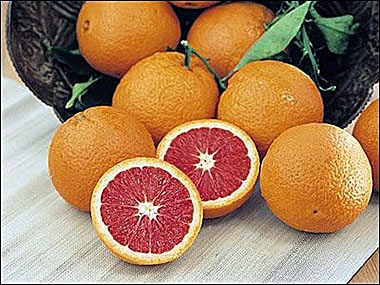Cara Cara
oranges, are a variety of navel oranges. They were first discovered in 1976 at
Hacienda Cara Cara in Venezuela and introduced in California during the 1980s.
This special orange is juicy, low in acid, seedless, and, some say, has a berry
like flavor. The name “cara cara” means “beloved” in Italian. When selecting
cara cara navel oranges, make sure the fruit is firm, heavy for its size, and
has a pleasant sweet smell.
Scars or
imperfect coloring do not reveal anything about the fruit’s flavor. When
storing, keep in a cool, well-ventilated place. They can last 3-4 days in room
temperature and up to 2 weeks in the refrigerator.
Like other naval
oranges, cara cara oranges have a partially developed fruit enclosed inside the
larger orange. A good orange will feel heavy for its size, indicating that it
is very juicy. The season for these oranges peaks at the height of winter,
meaning that they are available primarily in December and January in the
Northern Hemisphere. Unlike the blood orange, another orange with a distinctive
pigment, the rind of the cara cara does not betray the color of the interior,
and is typically a bright, glossy orange.
The flavor is
more complex than most navel varieties and has been described as evoking notes
of cherry, rose petal, orange, and blackberry.
While you can
get oranges year round in the grocery store, and even at many farmers markets,
Winter is the peek season for California’s cara cara navel oranges, and many
other citrus – like blood oranges, pomelos, mandarins, and oro blanco
grapefruits. These brightly colored beauties are bursting with vitamin C just
when the cooler and damp weather has us shut up indoors and more susceptible to
getting sick. Just one Cara Cara orange provides 150% of the daily recommended
value of vitamin C and 30% of vitamin A!
Because our bodies cannot store vitamin C, it is important for us to
regularly consume it.
These oranges
can be used in a variety of ways. Their slightly berry-like, sweet flavor
tastes delicious when eaten alone and in fruit salads, and the oranges can also
be juiced, eaten with yogurt or granola, or cooked into jams, jellies, and
other spreads.
Oranges are also
an important source of fiber, especially when eaten whole. The cara cara orange
is also a good source of folate and potassium, and a natural source of
Lycopene, the disease-fighting antioxidant that may be helpful in preventing
some cancers and protecting against cardiovascular disease. Lycopene, in fact,
gives the fruit its dark, rich coloring. On a rare occasion, the trees will
yield multicolored-leafed twigs instead of their usual green leaves. If the
twigs are left to grow and fruit, they can sometimes produce fruits with a
striped rind.
If you are looking
for the perfect gift for business associates, family or friends? A quick visit
to http://sunburstoranges.com can solve all of your fresh gift giving
adventures. We sell only the finest selections and the freshest citrus you can
buy.
Presented By:
Sunburst Oranges
180 South “E”
Street
Porterville,
CA 93257
559-561-3391


No comments:
Post a Comment